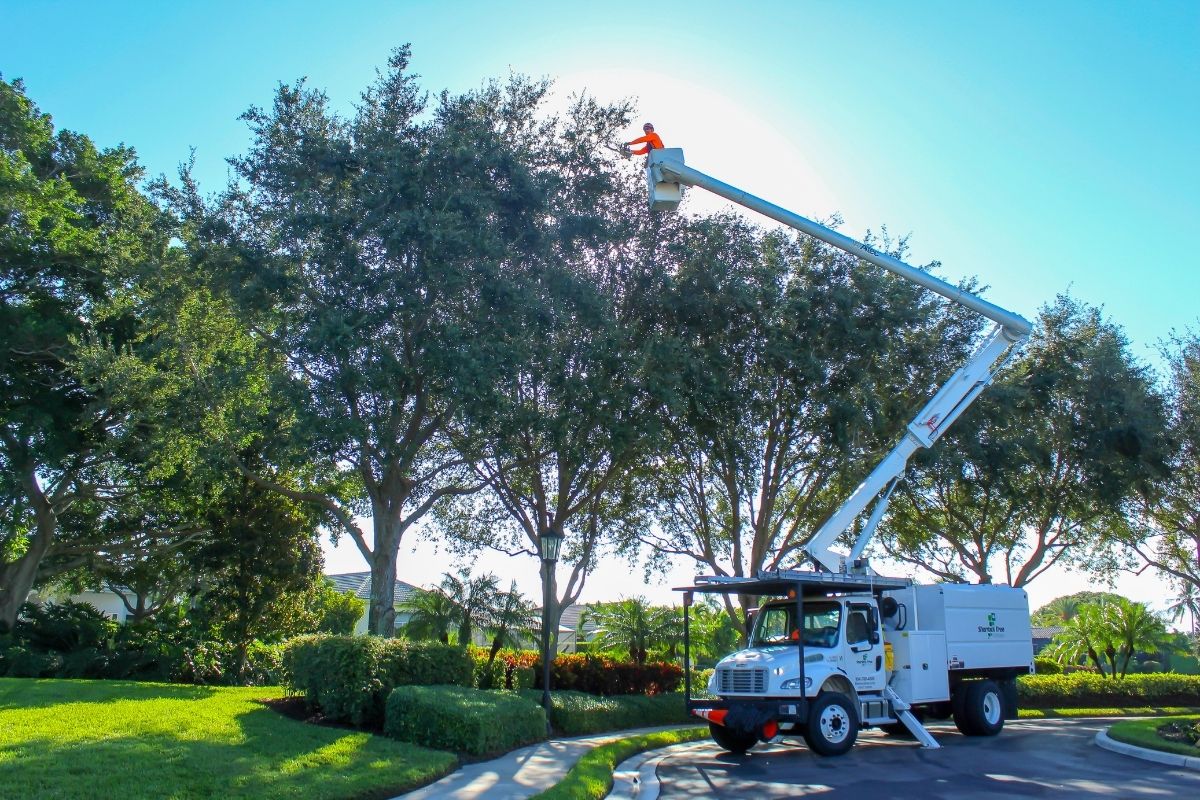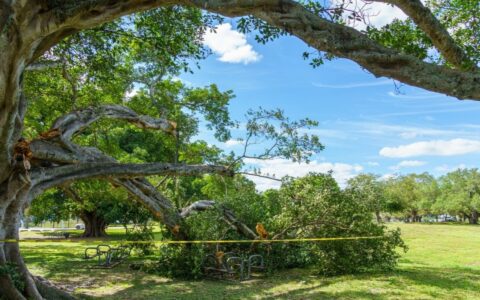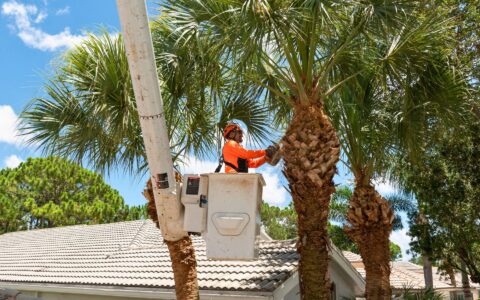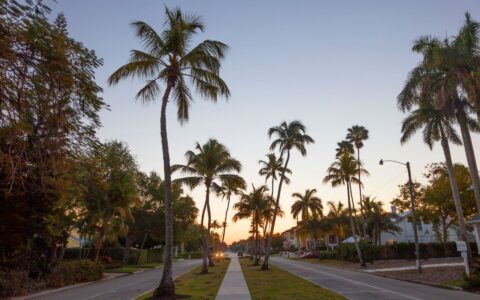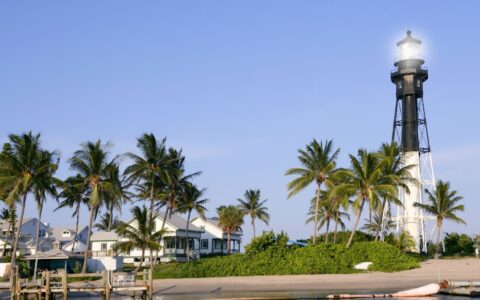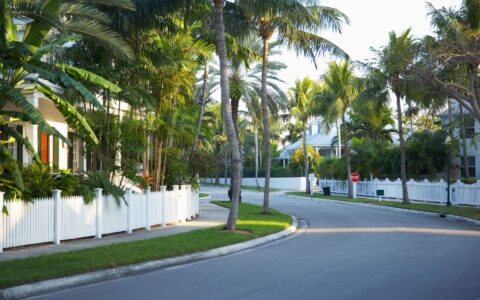Many homes in South Florida are part of a Homeowner’s Association or HOA. In fact, there are 48,500 HOAs in Florida and about 3.52 million homes in those Florida HOA communities. When HOAs are involved, there are often questions about who is responsible for trees within the community and on homeowners’ properties. Who maintains the trees, prunes them, or removes them? We address those questions and more in this article on tree care and HOAs in South Florida.
Who Owns the Tree According to Florida HOA Laws?
Although the question is short and sweet, the answer to it can be surprisingly convoluted.
Generally, the tree’s owner is the one who owns the property on which the tree’s trunk is rooted.
If there are community spaces around your neighborhood, the HOA will often be the owners of any trees in those areas. They will also be the ones in charge of managing those trees.
If the tree sits on the property line, it is called a “boundary tree.”. Both property owners must share responsibility for that tree according to Florida HOA laws. It’s illegal for one owner to remove a boundary tree without the other owner’s agreement. That includes if the tree is growing on the boundary between private and community property. In that situation, the property owner needs to gain the consent of the HOA to have the tree removed.
There are many extenuating circumstances that affect these general guidelines, particularly around the potential damage a tree can do to neighboring properties. There is extensive precedent Floridian law dealing with those situations but those are beyond the scope of this article.
Typical Tree Problems in HOAs
If you’re struggling to determine who should be taking care of the management of a specific issue with a tree, start by considering the problem and the property lines involved.
Tree on Private Property Impacts Community Property
Example – Roots from a tree on private property begin to disturb a sidewalk or other landscaping feature on community property. Even if the trunk of the tree rests entirely on your property, the HOA can ask you to cut back the roots of the tree, so they stop damaging community property. (Although the HOA can request it, we do not recommend cutting back tree roots unless absolutely necessary.) Your HOA might also take the management of this part of the tree into their own hands.
Either way, your HOA should let you know before they do anything that could impact your tree. That way, you can refute the claim if you believe that the work is unnecessary or will irreparably harm your tree. There are precedent cases that have gone both ways in the past in Florida HOA laws so it may be worth pursuing a case.
Example – A tree in the common area causes an issue on private property. For example, if the branches hang onto your home or obstruct your yard, you can ask the HOA to manage this. It is their responsibility to come out and trim the branches back to a safe distance from your home or property.
Alternatively, you can trim the branches yourself or have them trimmed by a tree service company. The majority rule in the U.S. states that if roots or branches from another landowner’s tree extend onto a neighboring property, the neighbor can trim them if it won’t kill the tree.
This rule is followed in Florida and applies to trees on community property that extend onto private property. Although it’s your right to trim these trees, it’s still best to talk to your HOA board about it first.
Example – One of the more common tree-related disputes is about leaves falling from one person’s tree onto another’s property. Whether that involves the HOA or another landowner, leaves are a natural product. They don’t give you the right to a nuisance claim even if they clog your gutters or pipes.
Tree Care Policies & Restrictions within an HOA
Florida’s statewide HOA laws can be confusing enough, but you also have to check into your local precedents. For example, in some locales, governing documents might state that the HOA board has the full right to make a final decision about any trees within the community.
In a few ways, that might seem restrictive. However, an HOA board given the right to make final decisions will also have the power to settle disputes. That way, community-centric disputes can get settled without moving further into a legal process.
Below are a couple of the primary ways HOA boards will often exercise this decision-making power when it comes to proper tree maintenance and tree removal.
HOA Restrictions on Tree Planting
HOA restrictions on the type of trees you plant on your property and where you can plant them might seem unfounded. However, they have their reasons for issuing these mandates to the community. Ultimately, the board of an HOA wants to curate a neighborhood that is aesthetically pleasing and safe for everyone.
Some of the reasons that an HOA might restrict you from planting a particular tree include:
- The tree species might be invasive
- The mature size of species or cultivar may be too large for the space or detract from the neighborhood’s aesthetic
- The tree has a high risk of safety issues due to its lack of wind resistance and tendency to easily break during storms
- Planting trees in inappropriate spaces or installing trees with hydrophilic roots can end up damaging community or private property
- Certain HOAs are trying to cultivate the neighborhood with a specific “look” and newly planted trees should fit that look
Not all HOAs have strict restrictions on the species, location, or size of the tree you plant. However, it is better to be aware of it if they do to avoid having to remove your new trees.
HOA Policies for Proper Tree Maintenance
Even if you have a tree located entirely on your property, the board can issue guidelines and requirements for taking care of your trees.
HOA tree care policies often work to keep the trees in the community as healthy as possible. These policies lead to the community reaping more of the potential benefits of trees to the South Florida region and bettering the community aesthetic. There has also been extensive research on the improvements more trees can have on mental and physical health.
These policies often include information about the proper trimming or pruning techniques for your trees. For example, if the tree becomes too large, the HOA’s policy may lay out the crown reduction methods that should be used.
The HOA’s policies may also provide guidance about the care of any new tree for the first two years after you plant or transplant it to help ensure its survival.
HOA Policies for Tree Removal
The HOA rules in Florida may require you to check with your HOA before removing a tree. That primarily depends on your neighborhood, but it’s better to check before removing the tree and receiving a hefty fine.
If a tree needs to be removed on community property, it is the responsibility of the HOA. It is also their prerogative to remove the tree even if there isn’t a specific problem that would require the tree to be cut down.
Often, checking with your HOA is essential since removing your own tree might not be allowed. You might need to get special permission from the HOA board or a committee to remove a tree. The HOA may also have an arborist or a tree service company they contract to do safe removals within the HOA and ensure the health of the surrounding landscape.
Trees Are an Asset to South Florida
HOA rules in Florida are in place to further the community and protect both the residents and their trees. Healthy, safe, and beautiful trees are an asset to any community and provide a huge range of benefits (including an increase in property prices when more trees are on the block).
It comes down to people’s desire to live in attractive neighborhoods with healthy, mature trees. Maintaining the trees you have and planting more can be an excellent way to grow your community into a healthy, thriving neighborhood.
If you or your HOA don’t have an arborist on call or are looking for a different tree service to work with, give Sherlock Tree Company a call! We work with many, many HOAs throughout South Florida. We would be happy to discuss your needs to see how we can best provide the services you need within your budget.
Call Sherlock for quality tree services
Whether you're looking for specific tree care services, such as palm trimming, tree removal, or disease treatments, or would like one of our Arborists to examine your trees to identify any issues and recommend options, we're always here for you! Just give us a call at 954-788-4000 to set up an appointment.
SEE MORE ARTICLES
Looking for more?
We've got you covered with a monthly newsletter full of tips, resources, updates, how-to's, and other helpful information about trees and landscapes in South Florida!



